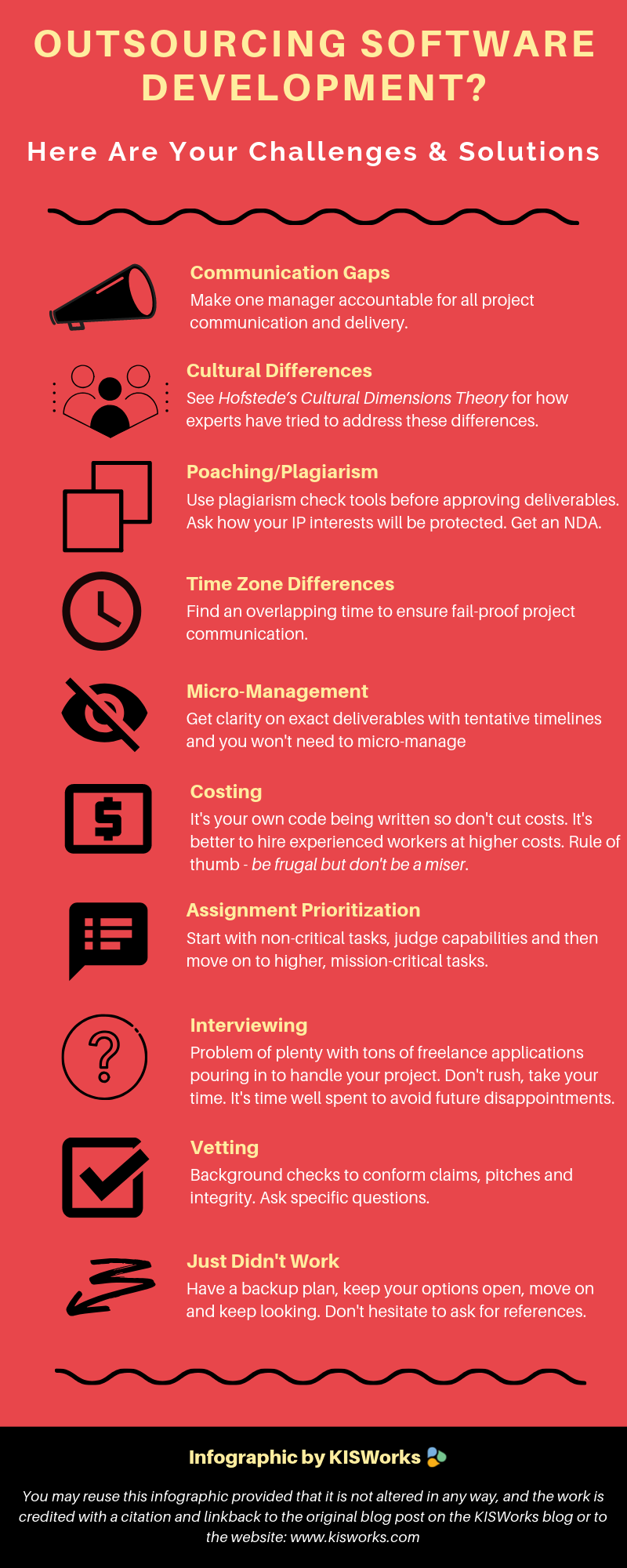Outsourcing has benefits! There’s all the data in the world to prove it. It saves a heck of costs if done correctly, not to mention the technological prowess a great offshore team can bring to your business. The greatest question however that surrounds the concept of outsourcing is ‘How to make it work?’
As with all great things in life, there’s a darker, hidden side to outsourcing too which needs to be carefully watched over and made to work to your advantage. So here’s a list of challenges with solutions that you may face, particularly as a first-time client trying to make outsourcing work for your business. See the infographic for a quick summary and read on for a detailed look…

#1. Communication Gaps
Quite often what you want is not communicated crisply enough for the team on the other side to understand and vice versa. Sometimes when working with freelancing agencies, a layer of middle management comes in between adding more communication gaps. Keep just one or two people in the team accountable for project delivery and communication while the rest of the team revolves around him/her.

#2. Cultural Differences
People from different areas of the world approach a problem or a topic from their personal or local experience which is greatly a factor of where and how they were brought up. So e.g., how workers in the US speak up about their views on something vs. how a worker from India expresses his opinions about it. Hofstede’s cultural dimensions theory is one example of how experts have tried to address these differences when simulating a cross-cultural environment in organizations.

#3. Poaching/Plagiarism
It is common for inexperienced freelancers to copy/lift proprietary code from sources without respecting the underlying licenses and modify it to suit their needs. There’s also a possibility of your code floating on the internet. Test your code with plagiarism checker tools before you approve/pay for it. Put an NDA in place and thoroughly vet your freelancers before offering them a position. Ask for solid references and steps they have in place to ensure the safety of your IP.

#4. Time Zone Differences
Many freelancers work in a time zone different than their clients. One of the parties needs to make an adjustment to ensure proper and constant communication.

#5. Micro-Management
No matter how qualified or experienced the hire, as a client you will always end up doing some level of micro-management. In any case the management rule of “Delegate and Forget” doesn’t work that well with most freelancers.

#6. Costing
Never go on a hunt for cheap freelancers/agencies trying to save money. Be frugal but don’t be a miser or else it will all come back to you as software debt, hurting your business in the long run.

#7. Prioritization of Outsourcing Assignments
Delegate only non-critical assignments first and after you have judged the capabilities and punctuality of the freelancer, you can move to bigger, time-critical tasks.

#8. Interviewing
Sometimes you may be overwhelmed with the sheer number of freelancers who will apply to your job or claim to do it. Keep it cool and take your sweet time to hire the best. Don’t hurry into it. Time spent here will save you from a lot of trouble later.

#9. Vetting
This is not the same as interviewing and requires a special mention. Do a thorough online background check on the freelancer before you hire. Many freelancers/agencies sub-let their work to other subordinate/satellite agencies but do not reveal it to you. Keep a check on quality + ask counter questions like “How did you begin writing this code? What was going through your mind? Why did you put these specific tests in your code, etc.” This way you can check the freelancer’s integrity and you stand a chance of discovering if the freelancer actually wrote the code or not.

#10. Just Won’t Work
Yes, it can happen to the best of us. There are times when it just won’t work. Always have a back-up plan. Keep your options open until you find a team that is just right for you. Don’t hesitate to keep by your side a trusted techie peer/friend of yours who can play the CTO’s role for your business when sifting through applications to your job and interviewing/assessing coding capabilities of an offshore team.

We Have Your Back!
Outsourcing can be a double-edged sword. While its potential is virtually limitless, so are its perils if handled incorrectly. If you are looking for a trusted software development company for Mobile Apps, Dot Net, Angular JS, UI/UX Design, and PHP development services then feel free to reach out to us via the forms on the linked pages. KISWorks has helped clients, small and big, over the years to turn their outsourcing efforts into delightful experiences.
